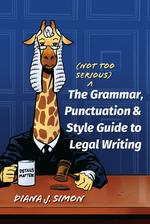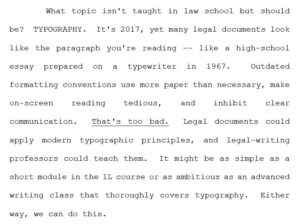Gathering opinions on new legal writers
In summer 2022, I had lunch meetings with five local attorneys. My goal was to gather input from practicing lawyers about ways I could improve my teaching of legal writing. Before meeting, I asked my “consultants” to consider three questions:
- What do you think of the writing abilities of the new lawyers you work with?
- What do you think of new lawyers’ ability to manage research and writing projects?
- What are some changes or additions to law-school legal-writing instruction you would recommend?
1. Writing abilities of new lawyers
I was pleased to learn that, according to my consultants, the writing ability of new lawyers these days is okay. No one was gushing about it—after all, new lawyers need lots of practice and experience to become skilled legal writers. But I was pleased that I didn’t hear any “the sky is falling” or “sound the alarm” reports.
I think that’s partly because formal legal-writing instruction in U.S. law schools, once almost non-existent, has been transformed in the last thirty years. At many schools, legal writing has moved from a low-credit, pass-fail course taught by teaching assistants to a graded course taught by full-time faculty.
Still, there’s room for improvement, and the most-common concerns expressed about new lawyers’ writing fell into three categories: tone, concision, and organization.
Tone: My consultants said that new lawyers sometimes write too formally, in a tone that is stiff or stilted. They guessed that new lawyers might be trying to sound … lawyerly. This is understandable, of course, and it’s a phase nearly every lawyer passes through. You’ve entered a learned profession, and you’ve become a licensed attorney, so you want to sound like one.[1] Yes, writing with an unduly formal tone is a flaw, but it’s not a major one. With some good feedback about audience and purpose, new lawyers will adapt to expectations and begin to adopt a readable tone.
Concision: New lawyers’ writing is sometimes wordy and verbose, my consultants said. They see long sentences, complex structures, and big words. But mostly, they said, they see documents that are too long. A memo the assigning lawyer thought would be five pages is ten; email messages that could be two or three paragraphs are five. New lawyers need to weed out extraneous details and unnecessary background and deliver the key information or analysis efficiently.
I agree that concise writing is a challenge for new lawyers, and my perspective as a teacher of first-year students makes me aware of a risk to keep in mind. If you apply pressure on novice legal writers to be concise, they might cut useful or necessary content just to achieve concision. In other words, to get the five-paragraph email down to three paragraphs, the beginner might just cut two paragraphs—perhaps removing a key legal standard or an important piece of the analysis.
What we want, of course, is for the writer to carefully edit all five paragraphs, removing a few words here, dropping an unnecessary comment there, and then consolidating so that we end up with three paragraphs. Ideally, they learn to achieve concision by a series of small edits that add up.
Organization. Even a concise piece of legal writing that uses the right tone still needs to be well organized, and in this area my consultants had two key comments: First, they wanted more up-front, bottom-line summaries in nearly everything thing they read. Spill the beans: get to the point first and put the background second, they said. It’s a common recommendation for all legal writing.[2] Second, the rest of the document should be sensibly ordered, with headings if necessary and strong topic and transition sentences.
These two key comments—the need for an up-front summary and the importance of a sensible, discernible order—highlight the reality of law practice: Lawyers are busy. These two techniques help busy lawyers read and understand efficiently.
2. New lawyers’ ability to manage research and writing projects
The responses to this question fell into three categories: Getting assignments, following up, and following through.
Getting assignments
I practiced law before the Internet, cell phones, and email, so the way I got assignments was almost always to go into someone’s office with a pen and pad in hand. I sat and took notes on what I was told.
It turns out that’s still a good idea, according to my consultants.
If possible, assigning attorneys and assignment-receiving new attorneys would meet in person to discuss the assignment. The new attorney should have something to write with—probably not just a cell phone.
Even when getting an assignment by email (the most common method, according to my consultants), it’s usually a good idea to drop by and talk. New attorneys should ask about the assigning attorney’s expectations on timing, depth, length, and so on to be sure they understand the assignment. Then, after some initial work, they should check back to be sure they’re on the right track.
Following up
New lawyers and law students tell me they sometimes avoid following up with questions because they don’t want to look inept or uninformed. But my consultants said that, in fact, not following up with the assigning attorney is a bigger problem than asking too many questions.
Although it doesn’t happen frequently, it’s a serious problem to do the research and write up a project that isn’t what the assigning lawyer wanted. Of course, it’s best to follow up only after you’ve done at least some research, so you’ll have something useful to say when you check back.
Sometimes the new lawyer gets a project and can’t find anything or, at least, anything that seems responsive to the assignment. When that happens, it’s important to follow up, but it’s just as important to be able to report back with “here’s what I did.” For example, it’s great if new attorneys can say, here are the research queries I submitted, or here are the types of authorities I consulted, or something like that.
Following through
According to my consultants, new lawyers should aspire to do more than merely answer the question; one recommendation is to include a short report on the best cases for and against the outcome predicted. In addition, new lawyers should invest in the problem: ask about it, care about it, try to get involved.
Some new lawyers make the mistake of assuming that it’s a senior attorney’s job to get them involved and pull them into projects. But getting involved is a new attorney’s job. New attorneys should become invested in the problem, ask follow-up questions, and care about the result for the client.
3. Recommended changes or additions to law-school legal-writing instruction
My consultants had lots of ideas, and I’ve listed some below. There are some great suggestions, but given that my focus is on first-year legal writing courses, I’ve categorized them into two groups: (a) good ideas that my colleagues and I are already doing, are hoping to do more of, or are planning for the future; and (b) good ideas that might become part of an upper-division course or clinic but that would be difficult to implement in the first-year legal-writing course.
(a)
- Oral assigning of projects
- Assignments given and responded to by email only
- Assignments that ask, “The client has done [or wants to do] X. What do you recommend?”
(b)
- Assignments to adapt a template motion or brief into a motion or brief on a different topic
- Assignments to find motions, briefs, and other pleadings prepared by opposing counsel
- Training in transactional drafting
- Assignments to boil down a complex transaction into a concise report
Overall, it was a great summer project that I hope to do again in a more systematic and expanded way.
_____
[1] Wayne Schiess, The Sound in Your Head, Austin Lawyer 6 (Nov. 2009).
[2] Wayne Schiess, Legal Writing Nerd: Be One 25-29, 30-36 (2018).

